Disclosure: Meeple Mountain received a free copy of this product in exchange for an honest, unbiased review. This review is not intended to be an endorsement.
It is entirely appropriate that the cover features an illustrated caboose, because a decorated hype train carried every last copy of 3 Ring Circus to GenCon this year. Devir deserves every marketing award for the anticipation surrounding this Fabio Lopiano title. We recently played one of his true gems, Calimala (primed for its forthcoming reprint with Alley Cat Games), which only inflated my hopes.
Situations like these never work out. Do they?
3 Ring Circus is the tale of building the best circus of acts and performing across a map of the eastern United States in the late 1800s. Mr Barnum is also on the map, traveling around to trigger scoring phases as he visits the big cities. Fame is the target–or at least that’s what the little popcorn icons want me to believe.
Get in the ring(s)
3 Ring Circus takes place on both a central board–a map of the eastern US–and the player board, which represents three “rings” of acts. As a turn, players either add a card to their board or perform somewhere on the map.
Each of the three rows on the player board holds five cards. Players add cards from left to right, maintaining an increasing value from least to greatest throughout the game. Card placement is fluid, though, so cards slide upon placement to accommodate the restriction. When a card’s value is greater than the greatest in the row, players pay the difference between the two. When a card’s value is less than the greatest, it joins the row for free. Some rows grow by increments, then, while others begin with a whopper and slowly flesh out the lower values at no cost.
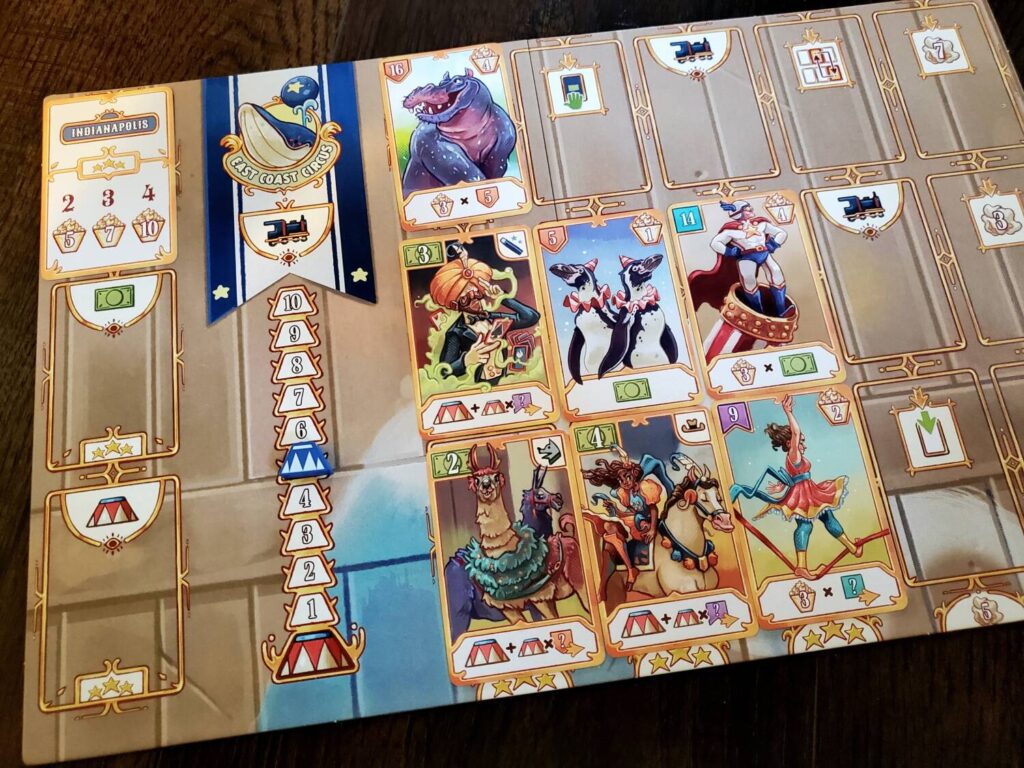
There are two types of cards. Money cards feature smaller acts, each of a particular type (pets, magicians, etc.), but also serve as the game’s currency. Ticket cards are divided among three types (acrobats, etc.), feature more prominent acts, score points at the end of the game, and cannot be spent as currency. All of the cards also include an effect at the bottom that impacts the gameplay at one time or another. If you love multi-use cards, then you’ve come to the right place.
Playing a card to the circus is simple: lay the card in an appropriate space according to its value, pay the cost in Money cards (if needed), and resolve any immediate effects, which come from covering the various spaces on the player board.
The performance action depends entirely on the size of the target city. Players begin by moving their marker according to the number of trains visible on their player board. Small towns are all about bolstering the cash supply. Players receive a Money card for each dollar visible on their board, then one for the city itself, and one for each adjacent small town that has yet to welcome a circus. As such, these performances send players to uncharted waters.

Medium cities are all about Pedestals. Various cards in a player’s circus will grant pedestals for achieving certain conditions. A card might give one pedestal, plus one for each orange (animal) act to the right of that card. There is a tracker on the player board to track the current status, because calculating is cumbersome once there are twelve or fifteen cards involved. Each of the medium cities grants Tickets or Fame points (the popcorn) based on the player’s Pedestal count. Each city also has a particular type of act that is hot (clowns, anyone?) that grants a bonus of two temporary Pedestals. Of course, each Pedestal count is only available once for each city, so bulk up and get there fast. Don’t forget to grab Money cards for any cash visible on the player board.
Large cities have very specific interests and provide loads of points. Bring the strong woman to Chicago and you’ll be allowed to perform. Haven’t found her yet? Try Pittsburgh again until you’re ready, dearie. But when you’ve got her, and if you have the right performers to her right and left in the ring, you’ll score big points. Getting there first comes with a reward. Oh, and the Money cards.
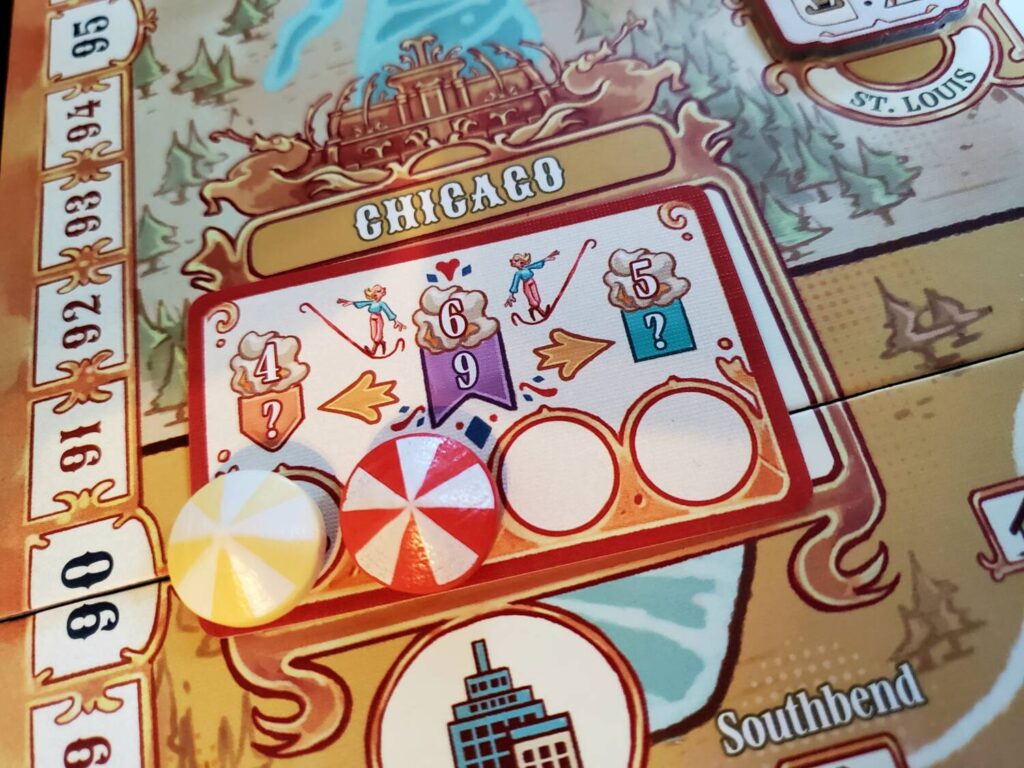
During every performance, players can also discard certain Money cards to enact their single-use effects (extra cash, movement, or Pedestals, etc.). After every performance, Mr Barnum moves one space around the perimeter of the map. When he reaches a large city, he triggers a scoring phase that grants point bonuses to the players with the most circus tents in that region.
Back on the player board, as the game progresses the rows and columns begin to fill. Filling a row unleashes a scoring bonus. Filling the first three columns allows for the placement of an endgame scoring card that was otherwise taking up dead space in your hand (limit of 10). Filling the final two columns brings more popcorn and more points. When Mr Barnum reaches his last large city, the game ends after the final region scoring. The endgame cards and the various acts then provide the last scoring boost (and it’s a doozy) before the winner celebrates with a swing on the flying trapeze.
Busy, busy, busy
Manalive there are a lot of icons on this board! I’ve played a two-player game in around 30 minutes, but everyone who sees the board for the first time gets a little glassy-eyed at the sheer number of things scattered about. Mind you, it all makes perfect sense to me, but there is a lot to soak in. Add in the fact that the cards are triple-use in some cases, and I think it’s fair to say 3 Ring Circus is not a gateway game.

But it’s a good game.
Busyness aside, the production is excellent. The little circus tents are spectacular. The card art is lovely. The icons are consistent and clear–there just happen to be a lot. The central board holds all the cards, including discards, with little room to spare. The player board holds the 15 cards pretty well, though sliding the middle row late in the game is potentially messy. And the box meets the Devir standard of “just enough room to squeeze it all in.”
As the player count decreases, a set of interlocking map pieces covers the regions that are no longer in play. Four players use all five regions, with three and two each using one less than the previous. Despite the change, the Barnum path never misses a beat. The design here is excellent. In a two-player affair, a third set of tents clutters the map a bit to impact the region scoring, but otherwise the various player counts follow the same ruleset.
The rulebook also includes minor variants for Barnum’s movement. These slight changes shift the game’s time signature by altering the frequency and order of the game’s scoring triggers. I appreciate the level of care!
Much to see
I’ve hinted at some of the minor glitches in the production, most of which are tied to the compact design and layout. We had a bit of confusion in our first play over the medium cities. They are printed in pairs around the board. In this way, they share some of their icons to eliminate the need to print more than one set. However, they might easily confuse players into thinking some of the features are combined: the desired acts, the even and odd Pedestal counts, etc.
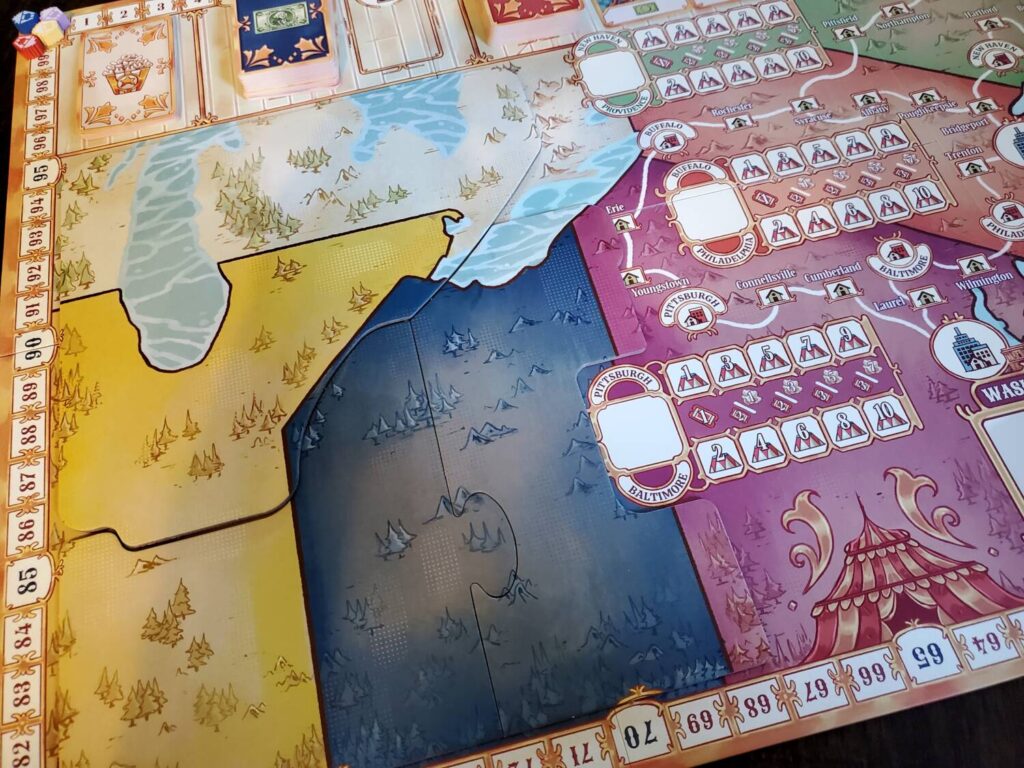
The endgame scoring cards are force-fed, meaning there is no choice involved. They are dealt, drawn at release points on the player board, and placed when able with none to spare. I can see folks disliking this feature, especially late in the game when an objective is suddenly thrust into the hand with little time to effect a favorable result. As this is an equal bane to all, I am not one to complain, but I’ve heard this to be the chief gripe with the design. If you want to add a thrill (or just more control), try drafting three and drawing them from a private pile or choosing two and keeping one. Something, anything, to lend a semblance of control.
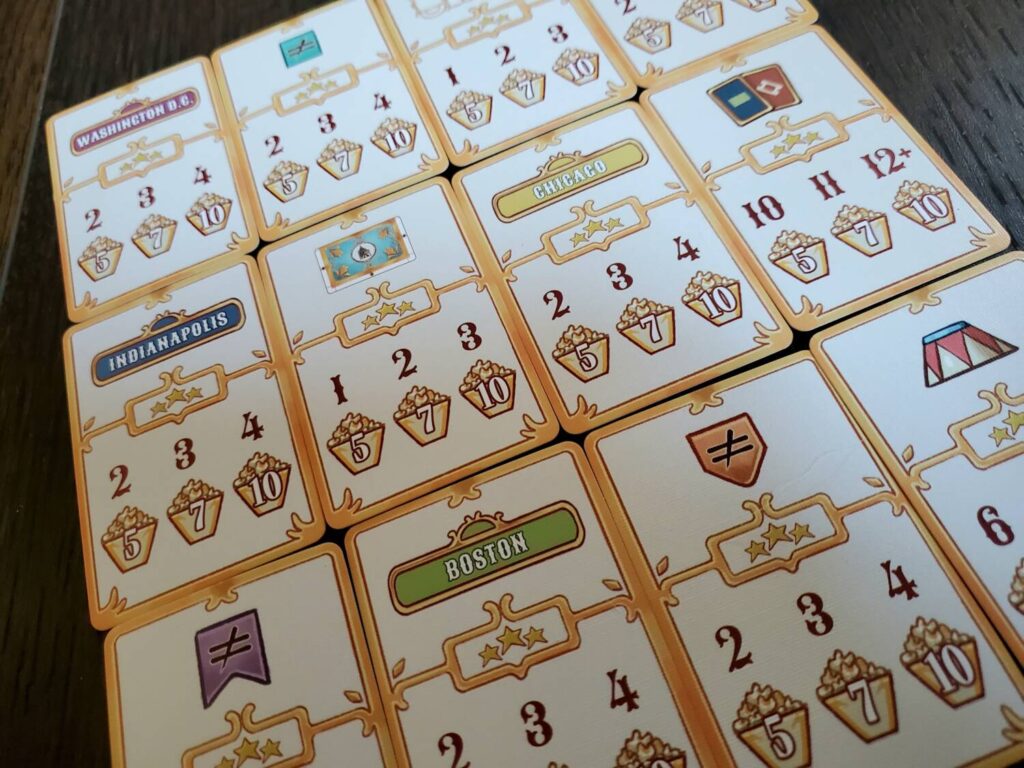
From a timing standpoint, 3 Ring Circus is entirely dependent on the players at the table. Every performance moves the timer–Mr Barnum. Players can push the game at a frantic pace, but at the cost of an underdeveloped circus. As the game rolls on, though, these considerations make for a fascinating tension. Someone must end the game before the whole table maximizes their everything. Have you built a good enough show to be that brave soul? The last few rounds are a test of each player’s half-baked intentions as the train rolls on.
Having played Calimala, I feel confident saying Fabio Lopiano knows how to create shifting tensions. With five region stops, players’ responsibilities are on a bungee-cord to establish a sufficient presence in the various regions to satisfy the area majority condition and exercise care over their own private objectives, which often overlap with various regions. Finding out late that you need tents in a region Barnum passed long ago is painful, but necessary in the pursuit of victory. I enjoy the way the game requires shifty eyes.
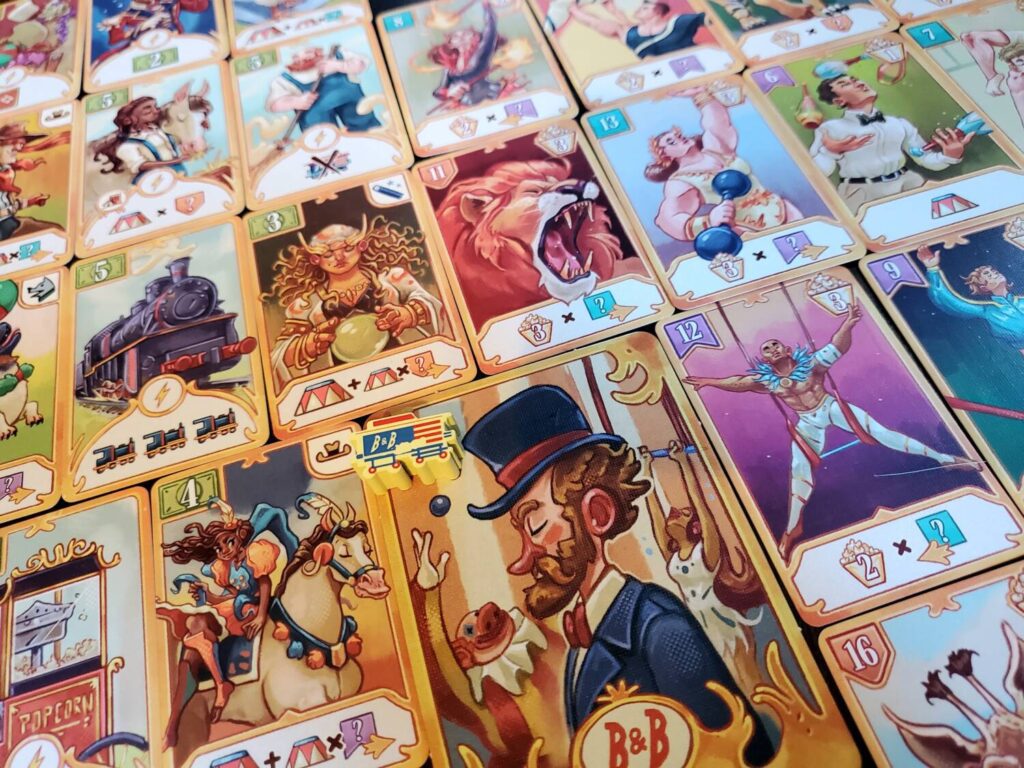
Speaking of that Barnum guy. Well done, Mr Lopiano. When Barnum hits a city, the player with the Barnum tile flips it, indicating the forthcoming scoring phase. But the phase holds off until the player with the Barnum marker finishes their turn. This might leave three turns to effect change in the region before scoring. Fantastic! Every time that tile flips, cold calculations fill the room as players determine their level of care for the shoe that’s about to drop.
Charming
I really do like 3 Ring Circus. Devir has been speaking my language of late with titles like Red Cathedral and Ierusalem Anno Domini. White Castle is on my list to check out as well as Bamboo. I like the way they put a game together, and the Lopiano circus is no different. A few production quibbles aside, I’m a fan of the mechanical combination here, the charm of the design, and the potential speed (depending on the player types).
I wish I could fire up the oven with some popcorn before I played for that truly authentic feel, but, you know, buttery fingers and board games really don’t mix.


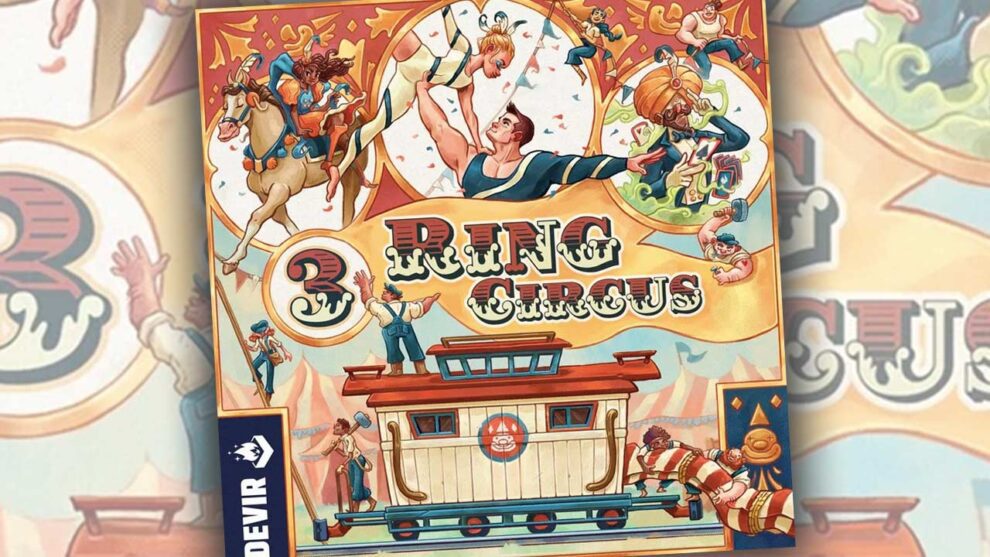









Add Comment